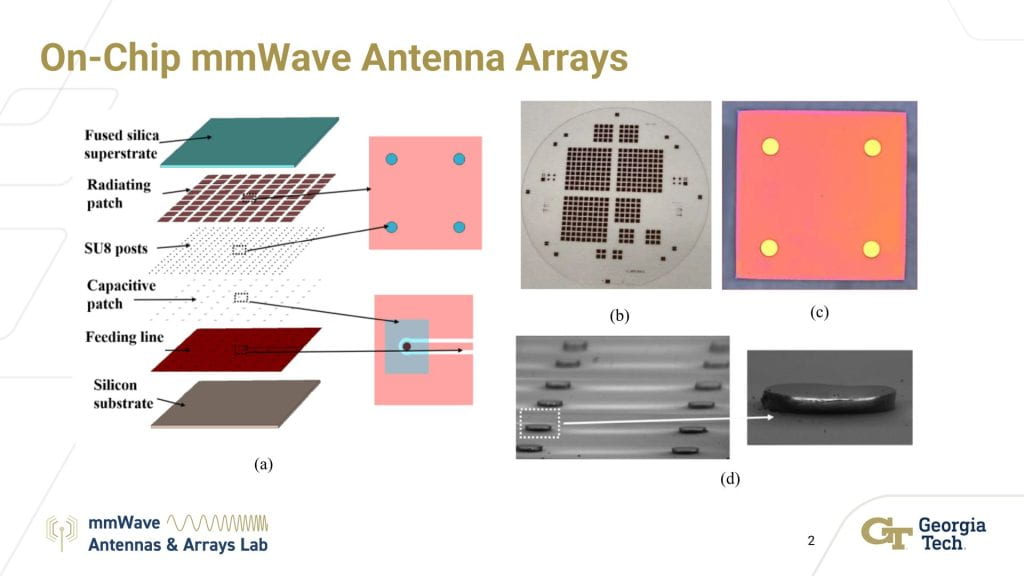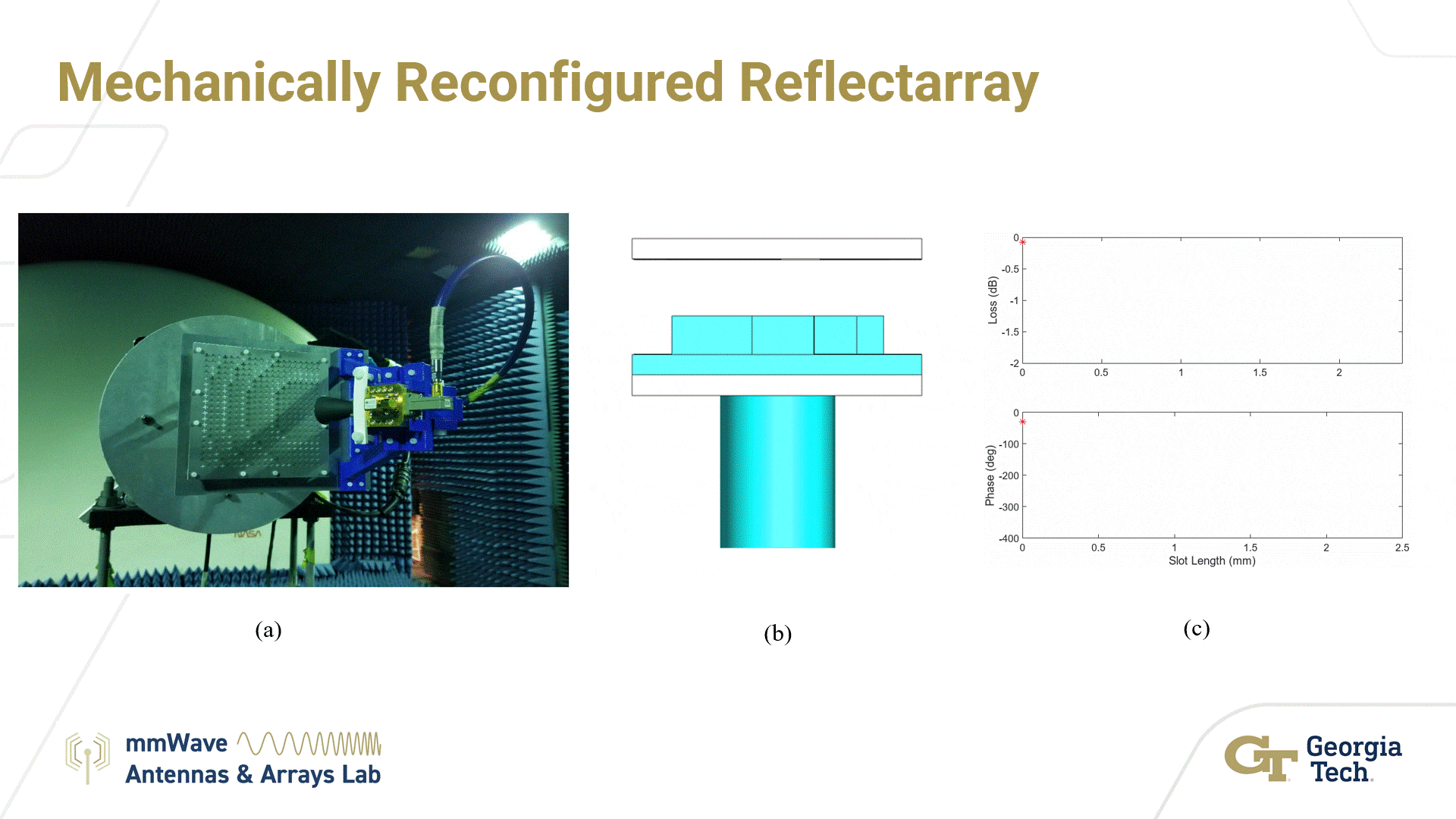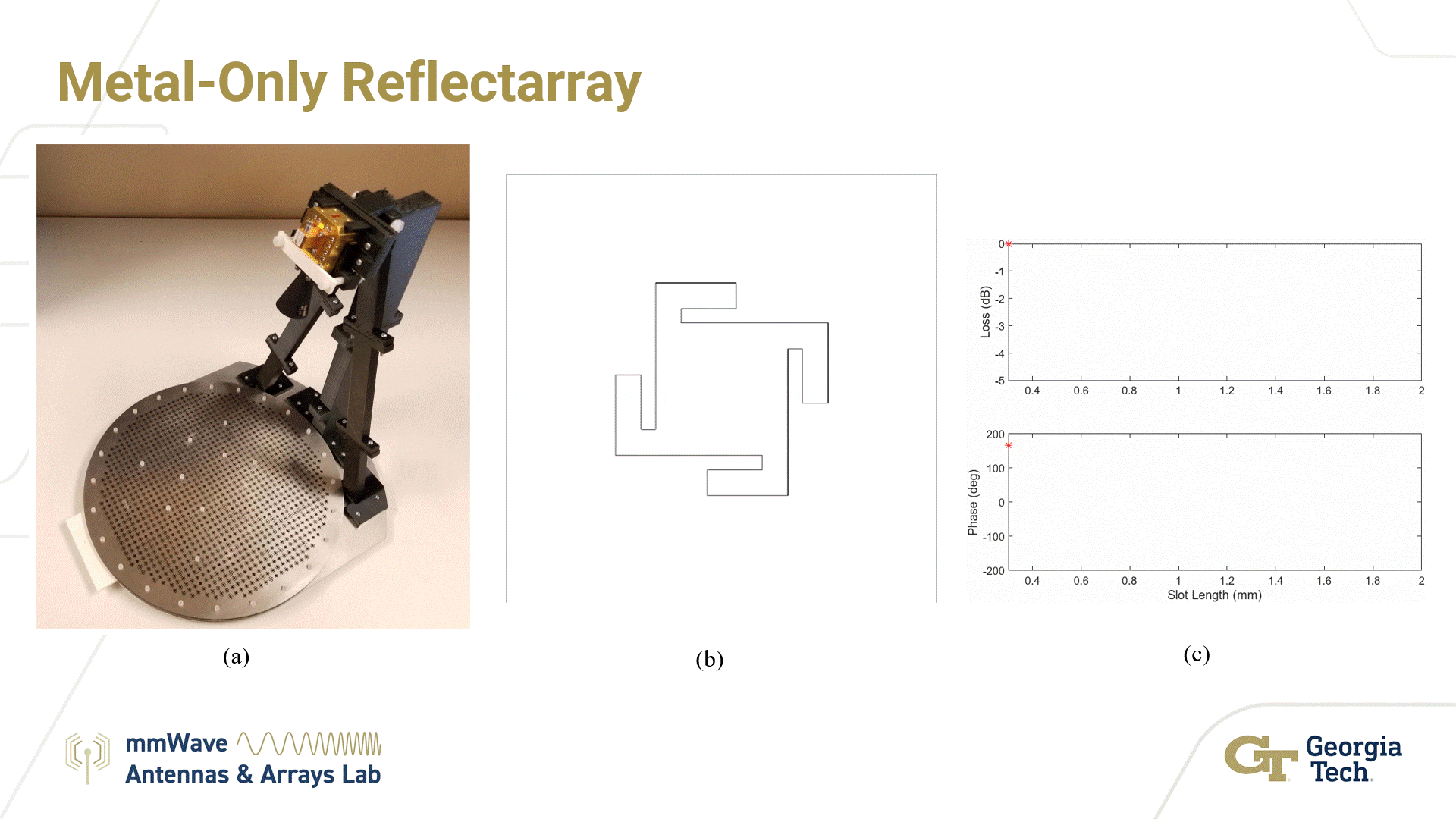
▶ Vanadium Dioxide for RF and mmWave Applications
Vanadium dioxide (VO2) is a phase-change material (PCM) exhibiting a sharp insulator-metal transition at a relatively low temperature of 68°C. The highly nonlinear change can be exploited for low-loss switching, sensing, power limiting, and other applications. Our fundamental studies include a dc reactive sputtering process for VO2 films, achieving resistivity contrast ratios on the order of 105 on c-plane sapphire and 104 on silicon with an annealed alumina buffer. A reliability study of VO2 mmWave CPW switches on sapphire indicated no statistically significant degradation of performance after 100 million switching cycles. We are conducting studies into the permittivity of our films as well as the self-transition mechanism under RF excitation.


▶ VO2-Based Circuits and Devices
The insulator-metal transition of VO2 can be exploited in a variety of passive yet tunable devices. Using photothermal excitation, VO2-based switches can operate from dc to 330 GHz with minimal losses. Power limiting and asymmetrical power threshold responses have been simulated in a thermo-optic VO2-based mid-infrared router. True-time-delay phase shifters and reconfigurable filters have been demonstrated at mmWave leveraging the wideband, low-loss characteristics of VO2.


▶ VO2-Based Periodic Surfaces
We take advantage of vanadium dioxide’s sharp nonlinearity and resistivity contrast to express power or energy selective behavior from incident fields. This allows low power waves to be collected but rejects in-band or near-in-band interference sources. Using the low-loss behavior of vanadium dioxide at mmWave we can make a dual-polarized 1-bit reflectarray with relatively high aperture efficiency. The surface uses the switches to independently switch the phase with an applied dc voltage to allow for independent steering of dual-linear polarization or steering and selecting a desired circular-polarization output.
Using low-loss vanadium dioxide switches combined with integrated microheaters we can switch between two meander-line polarizers to select a desirable circularly polarized output from the incident linear polarization. The 4-layer structure, packaged with flip chip bonding to bias PCBs, has silicon etched from the backside of each layer to increase matching and lower losses, which raises the overall efficiency of the surface. The thermal transition of vanadium dioxide is utilized to globally reconfigure a reflectarray such that in the off or cold state the surface transmits in one direction, but when it is excited with temperature to the on or hot state the surface transmits in the complementary direction.

▶ Quasi-Optical Free Space Measurement Setup
Reconfigurable metasurfaces have been of great interest to the scientific community for unique capabilities in wavefront manipulation. To evaluate the performance of these metasurfaces, our group has designed a free-space method using a pair of lensed horn antennas. These lens antennas are held using a 3-D printed mount, which can be tilted to a 45-degree angle on either side. The device under test (DUT) is located at the focal plane of these antennas on a rotating stage. One antenna produces a Gaussian beam, and a planar wavefront is incident onto the DUT. The receiving antenna, placed two wavelengths away, receives the Gaussian beam. Both antennas are connected to a network analyzer and the characteristics pertinent to the DUT’s performance are evaluated. The performance of a linear to circular polarization converter was tested using this setup.

▶ Robotic Antenna Measurement
Radiation pattern measurement of on-chip antennas is a significant challenge due to the need for coincident probing and the very small wavelengths in the mmWave band. To characterize mmWave antennas with high precision, we developed a robotic pattern measurement system using an industrial robot. This robot provides better than 20 μm repeatability and six degrees of freedom, enabling precise and versatile measurements. A MATLAB program controls the robot and positions it at specified locations. The robot can perform scans along planar and spherical trajectories around the antenna under test (AUT). Both the AUT and the probe are connected to a network analyzer to measure the gain of the antenna. We have developed a setup that enables measurements up to 400°C using a GSG probe. We have also designed a setup for W-band measurements using a frequency extender to extend the measurement range.


▶On-Chip Antennas & Arrays
Our group has developed silicon-based on-chip phased arrays for high-speed mmWave communication.
We have introduced a V-band on-chip array on silicon (Si) with beamforming capability. Using bulk micromachining processes to remove the substrate beneath the radiating element, our group has achieved one of the highest antenna efficiency in the literature. We also minimized mutual coupling by using a folded slot structure and vertical air cavities.
We have successfully demonstrated on a dielectric resonator antenna (DRA) using a silicon carbide (SiC) substrate, which ensures that the antenna performance is maintained in extreme environments. The use of corrugated edges reduces surface waves, thereby improving efficiency. The sapphire resonator and SiC are assembled using advanced Au-Au bonding. We have used a customized robotic system with modified probe station measured the DRA up to 400°C.
We used microelectromechanical systems (MEMS) processes to improve the radiation efficiency of a 60-GHz mmWave on-chip antenna array. (a) The stack up of the proposed antenna array, including a feed structure using capacitive patches. SU-8 posts suspend the patch array above the feed structure. (b) The fabricated prototype on a fused silica wafer. (c) A single fabricated patch element with SU-8 posts. (d) SEM images of the fabricated SU-8 posts.

▶ Mechanically Reconfigured Reflectarray
As compared to non-linear semiconductor-based approaches (e.g. PIN diode), a mechanically reconfigured reflectarray (RRA) has the ability to handle much higher power levels albeit with a slower reconfiguration speed. With the current commercially available piezoelectric or stepper motor actuators and relays, a mechanically reconfigurable reflectarray can handle high power levels with a wide bandwidth to replace both reflector antennas and phased arrays in certain applications shown in (a). In our design, by not including a lossy active device in the path of the configured field, mechanical reconfiguration allows the RRA unit cell to stay passive. The video (b) and (c) show how the phase and reflection coefficient change in the unit cell as the height of the dielectric insert changes.

▶ Metal-Only Reflectarray
Metal-only reflectarrays completely remove the dielectric substrate from the antenna, the elements of which are machined into a high strength and corrosive-resistant metal sheet such as stainless steel or aluminum shown in (a). The metal-only unit cell supports controlling the phase of both circular and linear polarization at the same rate with unit cell. The video (b) and (c) show how the phase and amplitude of the unit cell varies with slot length.

▶ Magnetically Reconfigurable Devices
Our group has designed and measured electromagnetic metasurfaces that are mechanically reconfigured using small magnetic fields.
(a) This research is in collaborative effort between Georgia Institute of Technology and Stanford Mechanical Engineering led by Prof. Renee Zhao (Zhao Lab). Magnetic NdFeB unit cells are designed to reconfigure into unique geometries under the impetus of an applied magnetic field. Arrays of these magnetic unit cells become the foundation for electromagnetic metasurfaces. Moreover, these structures are flexible, enabling the design of metasurfaces that can conform to various surfaces which is unattainable using standard, rigid reconfigurable metasurfaces.
(b) The magnetic blocks are metalized to generate specific electromagnetic responses. Z-Shaped patterns are applied to generate wide band filtering from 30–35 GHz. S-Shaped patterns are applied to generate dual band filtering from 25–27 GHz and 30–34 GHz.
(c) Current research is devoted to expanding the capabilities of these structures to perform additional electromagnetic functions. Reconfiguration is being used in conjunction with a PCB to develop novel structures. A discontinuous crossed dipole is patterned on the PCB such that the deployed and folded mechanical states convert linear to RHCP or LHCP respectively.


▶ Wirelessly Interrogatable, Implantable, Biodegradable Sensor
To address the challenges of anastomotic leak detection, a biodegradable, remotely interrogatable implantable sensor is being developed. The sensor architecture can be adapted to detect various analytes during the postoperative period. Utilizing biodegradable and bioresorbable materials eliminates the need for additional surgery to remove the device, reducing the risk of foreign body reactions. Potential targets for monitoring include pH changes to signal infections or duodenic leakage and analytes such as trypsin to predict pancreatic anastomotic leaks and bleeding to detect internal trauma.
The designed sensor composed of two interdigital capacitors (IDCs) and a split-ring resonator (SRR). The capacitance of the IDCs varies as the function of sensing film thickness. We balanced the trade-off between the metallic loss from the IDC structure and sensitivity against the thickness. We finally simulate the sensor in HFSS to validate that the sensor’s radar cross section (RCS) value is sensitive within the detection range.
